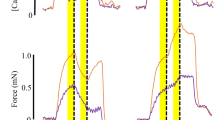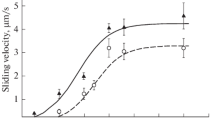Summary
The contraction induced by a Ca2+-independent myosin light chain kinase (MLCK-) was characterized in terms of isometric force (Fo), immediate elastic recoil (SE), unloaded shortening velocity (Vus), shortening under a constant load and ATPase activity of chemically skinned smooth muscle preparations. These parameters were compared to those measured in a Ca2+-induced contraction to assess the nature of cross bridge interaction in the MLCK-induced contraction. Fo developed in chicken gizzard fibers as well as SE were similar in contractions elicited by either agent. Vus in the contraction induced by MLCK-(0.36 mg/ml) was similar though averaged 39.3±8.9% less than Vus induced by Ca2+ (1.6x10−6M) in the control fibers. Addition of Ca2+ (1.6x10−6M) to a contraction induced by MLCK-resulted in small increases in both Fo and Vus. Shortening under a constant load was similar for both types of contractions. The contraction induced by MLCK-was accompanied by an increased rate of ATP hydrolysis. The MLCK-induced contraction is thus kinetically similar though not identical to a contraction induced by Ca2+. We conclude that with respect to actin-myosin interaction, MLCK- and Ca2+-induced contractions are similar.
Similar content being viewed by others
Abbreviations
- EGTA:
-
ethylene glycol bis (β-aminoethyl ether)-N, N, N′, N′-tetraacetic acid
- Tris:
-
tris (hydroxymethyl) aminomethane
- MLCK:
-
myosin light chain kinase
- MLCK:
-
Ca2+-independent form of MLCK
- SDS:
-
sodium dodecyl sulfate
- Vus :
-
velocity unloaded shortening
- Fo :
-
isometric force
References
Dillon, P. F., Aksoy, M. O., Driska, S. P., and Murphy, R. A., Myosin phosphorylation and the cross-bridge cycle in arterial muscle. Science211 (1981) 495–497.
Edman, K. A. P., The velocity of shortening at zero load: Its relation to sarcomere length and degree of activation of vertebrate muscle fibers, in: Cross Bridge Mechanism in Muscle Contraction, pp. 347–364. Eds H. Sugi and G. H. Pollack, University Park Press, Baltimore 1979.
Güth, K., and Junge, J., Low Ca2+ impedes cross-bridge detachment in chemically skinned taenia coli. Nature300 (1982) 775–776.
Hartshorne, D. J., Gorecka, A., and Aksoy, M. O., Aspects of the regulatory mechanism in smooth muscle, in: Excitation-Contraction Coupling in Smooth Muscle, pp. 377–384. Eds R. Casteels, T. Godfraind and J. C. Rüegg, Elsevier/North Holland, Amsterdam 1977.
Hartshorne, D. J., and Mrwa, U., Regulation of smooth muscle actomyosin. Blood Vessels19 (1982) 1–18.
Hellstrand, P., and Paul, R. J., Vascular smooth muscle: relation between energy metabolism and mechanics, in: Vascular Smooth Muscle: Metabolic, Ionic and Contractile Mechanisms. pp. 1–36. Eds M. F. Crass III and C. D. Barnes. Academic Press, New York 1982.
Marston, S. B., The regulation of smooth muscle contractile proteins. Prog. Biophys. molec. Biol.41 (1982) 1–41.
Murphy, R. A., and Mras, S., Control of tone in vascular smooth muscle. Archs intern. Med.143 (1983) 1001–1006.
Nonomura, Y., and Ebashi, S., Calcium regulatory mechanism in vertebrate smooth muscle. Biomed. Res.1 (1980) 1–14.
Paul, R. J., Doerman, G., Zeugner, C., and Rüegg, J. C., The dependence of unloaded shortening velocity on Ca2+, calmodulin, and duration of contraction in ‘chemically skinned’ smooth muscle. Circulation Res.53 (1983) 342–351.
Portzehl, H., Caldwell, P. C., and Rüegg, J. C., The dependence of contraction and relaxation of muscle fibers from the crabMaja squinado on the internal concentration of free calcium. Biochim. biophys. Acta79 (1964) 581–591.
Rüegg, J. C., and Paul, R., Vascular smooth muscle. Calmodulin and cyclic AMP-dependent protein kinase alter calcium sensitivity in porcine carotid skinned fibers. Circulation Res.50 (1982) 394–399.
Siegman, M. J., Butler, T. M., Mooers, S. U., and Davies, R. E., Calcium-dependent resistance to stretch and stress relaxation in resting smooth muscles. Am. J. Physiol.231 (1976) 1501–1508.
Siegman, M. J., Butler, T. M., Mooers, S. U., and Davies, R. E., Cross-bridge attachment, resistence to stretch, and viscoelasticity in resting mammalian smooth muscle. Science191 (1976) 383–385.
Solaro, R. J., Di Salvo, J., and Paul, R. J., Symposium: Coordination of Metabolism and Contractility by Phosphorylation in Cardiac, Skeletal, and Smooth Muscle. Fedn. Proc.42 (1983) 7–71.
Sparrow, M. P., Mrwa, U., Hofmann, F., and Rüegg, J. C., Calmodulin is essential for smooth muscle contraction. FEBS Lett.125 (1981) 141–145.
Walsh, M. P., Bridenbaugh, R., Hartshorne, D. J., and Kerrick, W. G. L., Phosphorylation-dependent activated tension in skinned gizzard muscle fibers in the absence of Ca2+. J. biol. Chem.257 (1982) 5987–5990.
Walsh, M. P., Dabrowska, R., Hinkins, S., and Hartshorne, D. J., Calcium-independent myosin light chain kinase of smooth muscle. Preparation by limited chymotryptic digestion of the calcium ion dependent enzyme, purification and characterization. Biochemistry21 (1982) 1919–1925.
Walsh, M. P., and Hartshorne, D. J., Actomyosin of smooth muscle, in: Calcium and Cell Function, Vol. III, pp. 223–269. Eds W. Y. Cheung. Academic Press, New York 1982.
Walsh, M. P., Hinkins, S., Dabrowska, R., and Hartshorne, D. J., Smooth muscle myosin light chain kinase. Methods Enzymol.99 (1983) 279–288.
Author information
Authors and Affiliations
Rights and permissions
About this article
Cite this article
Mrwa, U., Güth, K., Rüegg, J.C. et al. Mechanical and biochemical characterization of the contraction elicited by a calcium-independent myosin light chain kinase in chemically skinned smooth muscle. Experientia 41, 1002–1006 (1985). https://doi.org/10.1007/BF01952121
Published:
Issue Date:
DOI: https://doi.org/10.1007/BF01952121




